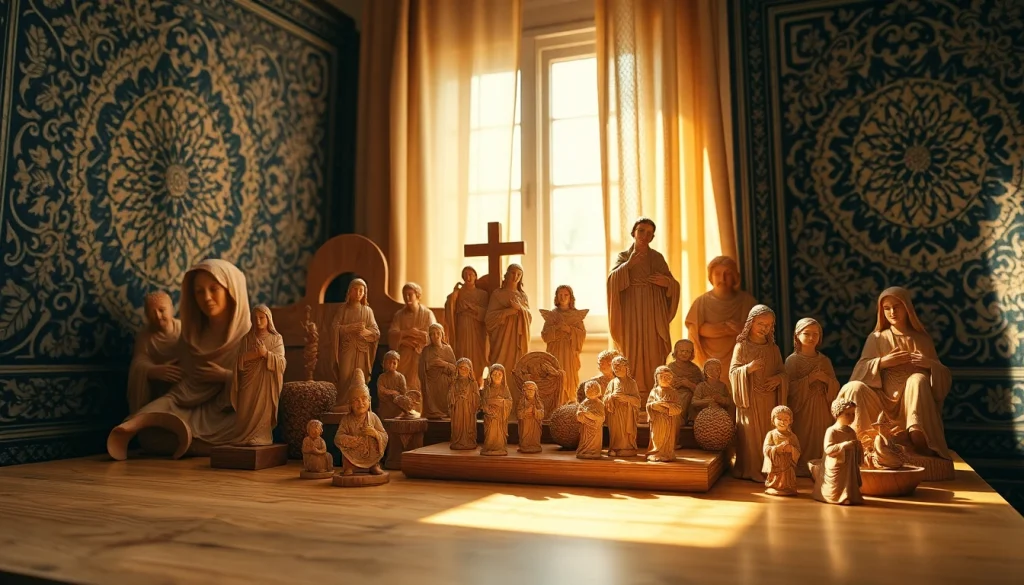The Timeless Art of Olive Wood Carvings
Olive wood carvings hold a special place in the tapestry of art, culture, and religious significance, particularly in regions like the Holy Land. These artistic creations are not merely decorative items; they embody a rich history intertwined with tradition and craftsmanship. Olive wood carvings serve as a testament to the enduring legacy of artisans who meticulously carve each piece from the wood of ancient olive trees. This article delves into the intricate world of olive wood carvings, exploring their characteristics, historical roots, cultural significance, and care tips, alongside guidance for selection, supporting artists, and incorporating these exquisite works into home decor.
Understanding Olive Wood: Characteristics and Benefits
Olive wood is revered for its unique characteristics, setting it apart from other types of wood commonly used in carving. Its dense fiber structure not only makes it durable but also lends a distinctive aesthetic appeal. The color ranges from creamy white to deep golden brown, often interspersed with dark streaks that enhance the overall beauty of the finished product.
Furthermore, olive wood is highly resistant to moisture and decay, making it an ideal material for both functional and ornamental items. This resistance is crucial in preserving the integrity of carvings over time, allowing them to withstand the test of time.
Another key benefit of olive wood is its eco-friendliness. As a byproduct of the olive oil industry, olive wood carvings utilize wood that would otherwise be discarded, promoting sustainable practices. Additionally, the olive trees themselves are often hundreds of years old, creating a tangible connection to history with every crafted piece.
Historical Significance of Olive Wood Carving
The tradition of olive wood carving dates back centuries, with roots embedded deep within the culture and practices of the Middle East. Historically, olive trees have been a cornerstone of Mediterranean agriculture, revered not only for their fruit but also for their wood. The art of carving emerged as a means to create both religious artifacts and everyday items, giving rise to a rich cultural legacy.
In Bethlehem and Jerusalem, skilled artisans passed down techniques and skills from generation to generation. Each carving tells a story, often reflecting religious themes and biblical narratives. The intricate details and craftsmanship involved in each piece underscore the importance of olive wood carving in religious practices—crosses, nativity scenes, and religious figurines dominate the market, serving both aesthetic and devotional purposes.
Common Tools and Techniques in Olive Wood Carving
Carving olive wood is a meticulous process requiring specific tools and techniques. Artisans utilize a combination of traditional hand tools and modern technology to achieve intricate designs. Common tools include chisels, knives, gouges, and carving tools, each serving a particular purpose from rough shaping to detailed finishing.
One of the most crucial phases in olive wood carving is the selection of the wood. Craftsmen prefer to use wood from mature trees, ensuring a rich grain and optimal carving qualities. Once selected, the wood is carefully dried and treated to prevent cracks and warping.
The carving process can vary, from roughing out a basic form to delicately texture and polish the surface. Artisans often draw inspiration from nature, religious symbols, and cultural motifs, ensuring each piece is not just functional but also a significant work of art. In addition, tree branches and other remnants can also be used, minimizing waste and maximizing craftsmanship.
Cultural Impact of Olive Wood Carvings
Religious Symbols and Their Meanings
Olive wood carvings are deeply intertwined with religious symbolism, especially within Christian communities in the Holy Land. The cross, for instance, is a common motif, serving as a significant reminder of faith. Additionally, nativity scenes, created in intricate detail, encapsulate the birth of Jesus and are popular during the Christmas season.
Each carving often carries a story, reflecting moral teachings or biblical events. The beauty of these carvings is that they not only serve as decor but also as a means of teaching and reinforcing faith among believers. Given their origins, each piece holds a historical significance, making it much more than just a product but rather a part of cultural heritage.
Artistic Representation in Modern and Traditional Contexts
Over the years, olive wood carvings have transcended traditional forms, finding a place in modern art as well. Contemporary artists are reinterpreting classical motifs and infusing them with modern aesthetics. This blending of the old and the new is attracting a wider audience, ensuring the craft remains relevant in today’s art scene.
Moreover, workshops and exhibits often showcase both traditional and contemporary pieces, providing a platform for artisans to display their work to global audiences. This has sparked interest in olive wood carvings not just as religious symbols but as artistic expressions capable of transcending cultural boundaries.
Role of Olive Wood Carvings in Communities
Olive wood carving plays a vital role in the livelihoods of artisans in the Holy Land. Many families rely on the craft for their economic sustenance, fostering a community that thrives on artistic expression. Craftsmanship is passed down through generations, preserving skills that might otherwise be lost in today’s fast-paced consumer world.
Additionally, community initiatives and cooperatives are promoting the sale of handcrafted olive wood items, allowing artisans to reach broader markets while encouraging fair trade practices. These initiatives not only support local economies but also elevate the status of handcrafted art, ensuring that the legacy of olive wood carving continues well into the future.
Choosing Quality Olive Wood Carvings
Identifying Authentic Handcrafted Products
When selecting olive wood carvings, authenticity is crucial. Many mass-produced items may not hold the same quality or cultural significance as handcrafted pieces. To identify authentic products, consider the following:
- Source: Verify that the products come from reputable artisans or cooperatives in regions known for olive wood carving.
- Craftsmanship: Examine the details. Handcrafted pieces should reflect skillful craftsmanship with smooth finishes, intricate designs, and natural wood characteristics.
- Materials: Genuine olive wood will have a unique grain pattern and warm hues that set it apart from inferior materials.
Factors Affecting Quality and Price
Several factors influence the quality and price of olive wood carvings. The most significant include:
- Size: Larger pieces often demand higher prices due to the amount of material and labor involved.
- Complexity: Intricate designs with fine details require more skill and time, impacting the overall cost.
- Artisan Reputation: Established artisans with a reputation for quality craftsmanship may price their work higher than newer or less experienced carvers.
Popular Online Retailers for Olive Wood Carvings
Thanks to the rise of e-commerce, purchasing olive wood carvings has never been easier. Several online retailers offer a diverse range of products, catering to different tastes and budgets. Some popular retailers include:
- Holy Land Gift Shop – Specializing in intricate sculptures and religious artifacts.
- Bethlehem Handicrafts – Offering a broad collection of masterpiece statues and decorative pieces.
- Bethlehem Art – Focused on figurines and small decorative items.
Caring for Your Olive Wood Carvings
Proper Cleaning and Maintenance Techniques
To ensure that your olive wood carvings remain a cherished part of your home for years to come, proper care is essential. Here are some tips to keep in mind:
- Dust Regularly: Use a soft, dry cloth to gently dust your carvings, preventing the buildup of dirt and grime.
- Avoid Water: Olive wood is resistant to moisture, but excessive water can still damage the wood. Clean with a damp cloth, ensuring no water seeps into the grain.
- Oil Occasionally: To preserve the wood’s natural beauty, apply food-safe mineral oil every few months, enhancing its luster and protecting against dryness.
Storage Tips to Preserve the Artwork
When not displayed, it’s crucial to store olive wood carvings properly to maintain their quality:
- Climate Control: Keep carvings in a stable environment, avoiding extreme temperatures and humidity.
- Use Soft Liners: Store the pieces in soft cloth bags or bubble wrap to prevent scratches and damage.
- Avoid Direct Sunlight: UV light can fade the wood’s colors; therefore, opt for storage areas that are dark and cool.
Common Mistakes to Avoid with Wooden Art Pieces
As beautiful as olive wood carvings are, some common mistakes can lead to damage:
- Avoiding Proper Dusting: Leaving dust accumulation can result in scratches and dull the finish over time.
- Using Harsh Chemicals: Refrain from using waxy furniture sprays or ammonia-based cleaners that can damage the wood’s surface.
- Neglecting Regular Maintenance: Infrequent oiling can cause the wood to become dry and susceptible to cracks.
Incorporating Olive Wood Carvings into Your Home Decor
Creative Ways to Showcase Olive Wood Art
Incorporating olive wood carvings into home decor can inspire warmth and add character to any space. Here are creative ideas for showcasing these works of art:
- Display as Focal Points: Position larger carvings in entryways or living rooms as statement pieces, drawing attention and sparking conversation.
- Create Themed Vignettes: Arrange multiple smaller carvings together on shelves, mixing heights and sizes for visual interest.
- Use as Centerpieces: Use olive wood bowls or figurines as striking centerpieces on dining tables or coffee tables, melding functionality with beauty.
Pairing Olive Wood with Other Design Elements
The natural tones and textures of olive wood pair beautifully with various design elements:
- Contrasting Materials: Olive wood complements stone and metal décor, allowing its warm tones to shine against cooler, more industrial elements.
- Textured Fabrics: Pair carved items with soft textiles like linen or cotton to create inviting layers within your decor.
- Natural Elements: Surround your olive wood pieces with plants or flowers, enhancing the organic feel and promoting a harmonious environment.
Inspiration for Gift Giving: Olive Wood Carvings for All Occasions
Olive wood carvings make meaningful gifts, well-suited for various occasions. Here are some inspiring ideas:
- Weddings: Personalized olive wood serving trays or cutting boards can serve as memorable and practical gifts.
- Religious Milestones: Crosses or angel figurines can be heartfelt gifts for baptisms, confirmations, or first communions.
- Housewarming Presents: Beautifully crafted bowls or decorative items can add warmth and charm to new homes, reminding recipients of their roots.



